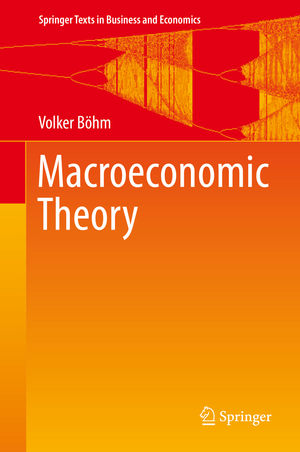Macroeconomic Theory: Springer Texts in Business and Economics
Autor Volker Böhmen Limba Engleză Hardback – 13 noi 2017
| Toate formatele și edițiile | Preț | Express |
|---|---|---|
| Paperback (1) | 471.27 lei 38-45 zile | |
| Springer International Publishing – 24 mai 2018 | 471.27 lei 38-45 zile | |
| Hardback (1) | 522.64 lei 38-45 zile | |
| Springer International Publishing – 13 noi 2017 | 522.64 lei 38-45 zile |
Din seria Springer Texts in Business and Economics
- 17%
 Preț: 460.17 lei
Preț: 460.17 lei -
 Preț: 548.25 lei
Preț: 548.25 lei - 17%
 Preț: 490.71 lei
Preț: 490.71 lei - 13%
 Preț: 447.86 lei
Preț: 447.86 lei - 19%
 Preț: 509.83 lei
Preț: 509.83 lei -
 Preț: 360.02 lei
Preț: 360.02 lei -
 Preț: 374.88 lei
Preț: 374.88 lei - 17%
 Preț: 523.87 lei
Preț: 523.87 lei -
 Preț: 374.15 lei
Preț: 374.15 lei -
 Preț: 185.09 lei
Preț: 185.09 lei - 17%
 Preț: 522.65 lei
Preț: 522.65 lei - 19%
 Preț: 465.61 lei
Preț: 465.61 lei - 15%
 Preț: 642.51 lei
Preț: 642.51 lei - 18%
 Preț: 754.79 lei
Preț: 754.79 lei - 19%
 Preț: 534.44 lei
Preț: 534.44 lei -
 Preț: 360.47 lei
Preț: 360.47 lei -
 Preț: 359.93 lei
Preț: 359.93 lei - 17%
 Preț: 363.29 lei
Preț: 363.29 lei - 17%
 Preț: 363.98 lei
Preț: 363.98 lei -
 Preț: 473.41 lei
Preț: 473.41 lei -
 Preț: 361.12 lei
Preț: 361.12 lei - 8%
 Preț: 428.31 lei
Preț: 428.31 lei - 15%
 Preț: 479.55 lei
Preț: 479.55 lei - 13%
 Preț: 490.93 lei
Preț: 490.93 lei - 15%
 Preț: 650.55 lei
Preț: 650.55 lei -
 Preț: 382.19 lei
Preț: 382.19 lei - 15%
 Preț: 562.13 lei
Preț: 562.13 lei -
 Preț: 367.41 lei
Preț: 367.41 lei -
 Preț: 401.79 lei
Preț: 401.79 lei -
 Preț: 361.89 lei
Preț: 361.89 lei - 15%
 Preț: 562.31 lei
Preț: 562.31 lei - 17%
 Preț: 491.52 lei
Preț: 491.52 lei - 20%
 Preț: 819.24 lei
Preț: 819.24 lei - 15%
 Preț: 597.20 lei
Preț: 597.20 lei -
 Preț: 320.05 lei
Preț: 320.05 lei - 20%
 Preț: 694.03 lei
Preț: 694.03 lei - 20%
 Preț: 693.46 lei
Preț: 693.46 lei -
 Preț: 548.53 lei
Preț: 548.53 lei - 17%
 Preț: 459.67 lei
Preț: 459.67 lei - 17%
 Preț: 366.16 lei
Preț: 366.16 lei - 20%
 Preț: 693.82 lei
Preț: 693.82 lei -
 Preț: 555.90 lei
Preț: 555.90 lei - 9%
 Preț: 766.64 lei
Preț: 766.64 lei
Preț: 522.64 lei
Preț vechi: 645.24 lei
-19% Nou
Puncte Express: 784
Preț estimativ în valută:
100.01€ • 106.94$ • 83.38£
100.01€ • 106.94$ • 83.38£
Carte tipărită la comandă
Livrare economică 14-21 aprilie
Preluare comenzi: 021 569.72.76
Specificații
ISBN-13: 9783319601489
ISBN-10: 3319601482
Pagini: 406
Ilustrații: XVII, 423 p. 175 illus., 76 illus. in color.
Dimensiuni: 155 x 235 x 23 mm
Greutate: 0.76 kg
Ediția:1st ed. 2017
Editura: Springer International Publishing
Colecția Springer
Seria Springer Texts in Business and Economics
Locul publicării:Cham, Switzerland
ISBN-10: 3319601482
Pagini: 406
Ilustrații: XVII, 423 p. 175 illus., 76 illus. in color.
Dimensiuni: 155 x 235 x 23 mm
Greutate: 0.76 kg
Ediția:1st ed. 2017
Editura: Springer International Publishing
Colecția Springer
Seria Springer Texts in Business and Economics
Locul publicării:Cham, Switzerland
Cuprins
Introduction.- Microeconomic Foundations.- Models of Monetary Equilibrium.- Dynamics of Monetary Equilibrium Models.- Fiscal Policy and the Dynamics of Monetary Equilibrium.- The Keynesian Model with Money.- Dynamics in Disequilibrium - Endogenous Business Cycles.- Disequilibrium Dynamics with Random Perturbations.- Dynamical Systems in Discrete Time.- Proofs and Further Results.
Notă biografică
Volker Böhm is a Professor Emeritus at Bielefeld University.
Textul de pe ultima copertă
This textbook offers a unique approach to macroeconomic theory built on microeconomic foundations of monetary macroeconomics within a unified framework of an intertemporal general equilibrium model extended to a sequential and dynamic analysis. It investigates the implications of expectations and of stationary fiscal policies on allocations, on the quantity of money, and on the dynamic evolution of the economy with and without noise. The text contrasts and compares the two main competing approaches in macroeconomics within the same intertemporal model of a closed monetary economy: the one postulating full price flexibility to guarantee equilibrium in all markets at all times under perfect foresight or rational expectations, versus the so called disequilibrium approach where trading occurs at non- market-clearing prices and wages when these adjust sluggishly from period to period in response to market disequilibrium signals.
This novel text blends smoothly the behavioral toolsthat underlie modern macro: real and monetary, short and long run, classical and Keynesian, competitive and monopolistic, deterministic and stochastic. It belongs in the reading list of teachers and in the library of every practitioner.
Prof. Costas Azariadis, Washington University in St. Louis, USA
Prof. Costas Azariadis, Washington University in St. Louis, USA
Caracteristici
Presents a unique approach to macroeconomic theory based on microeconomic foundations, general equilibrium theory, and dynamic analysis of fiscal and monetary policies Provides a synthesis of equilibrium and disequilibrium macro models with money unifying the features of microfounded temporary equilibrium and Keynesian models Analyzes the dynamics of business cycles in deterministic and stochastic environments using bifurcation theory Exhibits the power of numerical methods to investigate time series of explicit nonlinear dynamic stochastic monetary models Includes supplementary material: sn.pub/extras




















